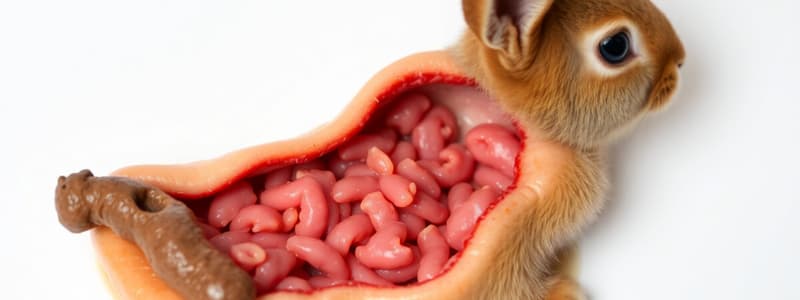Podcast
Questions and Answers
Which of the following best describes the function of cecal retropulsion in rabbits?
Which of the following best describes the function of cecal retropulsion in rabbits?
- Separating digestible and undigestible material at the fusi coli.
- Moving hard fecal pellets through the distal colon.
- Refluxing digestible material back into the cecum for fermentation. (correct)
- Expelling undigestible material from the hindgut.
What is the primary composition of cecotrophs in rabbits?
What is the primary composition of cecotrophs in rabbits?
- Fermented cecal material rich in B-vitamins, vitamin K and bacterial protein. (correct)
- Primarily water and minerals.
- Exclusively fibrous, undigested plant material.
- A mixture of undigested material and bile acids.
The fusi coli plays what role in the large intestine?
The fusi coli plays what role in the large intestine?
- Secreting digestive enzymes into the proximal colon.
- Absorbing water from the digested material.
- Seperating digestible from undigestible material. (correct)
- Facilitating the expulsion of cecotrophs.
What triggers the consumption of cecotrophs in rabbits?
What triggers the consumption of cecotrophs in rabbits?
Approximately how long after feeding are cecotrophs produced and passed?
Approximately how long after feeding are cecotrophs produced and passed?
Flashcards
Hindgut fermenter
Hindgut fermenter
An animal that ferments food in the large intestine, specifically the cecum.
Cecum
Cecum
The part of the large intestine that functions as the primary fermentation site, comprising 40% of the GI volume.
Fusi coli
Fusi coli
A muscular sphincter at the junction of the proximal and distal colon, regulating material flow.
Cecotrophy
Cecotrophy
Signup and view all the flashcards
Cecotrophs
Cecotrophs
Signup and view all the flashcards
Study Notes
Cecotrophy in Rabbits
- Rabbits are hindgut fermenters and coprophagic
- The cecum is 40% of the gastrointestinal tract volume, the primary site for fermentation
- The proximal colon is enlarged and has folds, facilitating cecal retropulsion
- A muscular sphincter (fusus coli) separates the proximal and distal colon
- Digestible material is separated from indigestible material in the fusi coli
- Digestible material is sent back to the cecum for further fermentation
- Solid waste is excreted as hard pellets during the day
- Soft, cecal pellets (cecotrophs) are produced approximately 8 hours after eating
- Cecotrophs are rich in B vitamins, vitamin K, and bacterial protein
- Cecotrophs are passed at night, typically during mass movements of the intestines
- Rabbits lick cecotrophs at the anus, moving them to their mouths
- Housing rabbits on wire prevents cecotrophs from hitting the ground, but does not stop cecotrophy
Studying That Suits You
Use AI to generate personalized quizzes and flashcards to suit your learning preferences.

